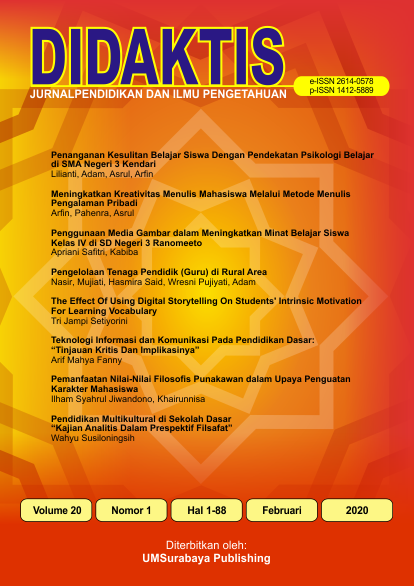Teknologi Informasi dan Komunikasi Pada Pendidikan Dasar: “Tinjauan Kritis dan Implikasinyaâ€
Abstrak
Kajian literatur ini bertujuan meninjau implikasi teknologi informasi dan komunikasi (TIK) pada pendidikan dasar secara kritis pada jurnal ilmiah hasil dari penelitian yang relevan tentang penggunaan TIK dalam pendidikan. Pada khususnya kajian ini untuk meninjau manfaat integras dan hambatan dan tantangan yang dihadapi pada penggunaan TIK serta faktor keberhasilan dalam mengintegrasikan TIK yang mempengaruhi percaya diri guru untuk menggunakan TIK saat proses pembelajaran dan juga keharusan sekolah dalam mendukung penggunaan TIK oleh tenaga pendidik. Guru dapat memperhatikan karakteristik perkembangan peserta didik di sekolah dasar, sebab siswa usia SD berada pada tingkat berpikir konkrit. Dengan dukungan penggunaan TIK dapat meningkatkan kualitas belajar dan mengajar karena dengan TIK materi mampu disajikan dalam bentuk yang lebih kongkrit. Didukung dengan pendekatan pengajaran yang sesuai perkembangan sisiwa dan juga dukungan teknis supaya memungkinkan guru mempertahankan budaya yang sekaligus memfasilitasi pembelajaran dengan teknologi yang sesuai era perkembangan masa kini.
Artikel teks lengkap
Referensi
Brush, T., Glazewski, K. D., & Hew, K. F. (2008). Development of an instrument to measure preservice teachers' technology skills, technology beliefs, and technology barriers. Computers in the Schools, 25(1-2), hal. 112-125.
Chai, C. S., Koh, J. H. L. and Tsai, C.-C., 2010. Facilitating preservice teachers’ development of technological, pedagogical, and content knowledge (TPACK). Educational Technology and Society, vol. 13, hal. 63-73.
Gee, J. P. 2011._Language and learning in the_digital age. New York:_Routledge
Kent, N._and Facer,_K. 2004., Different worlds? A comparison of young people’s home and school ICT use. Journal of Computer Assisted Learning, vol. 20, Hal. 440-455.
Levin, T. and Wadmany, R., 2006. Teachers’ beliefs and practices in technology-based classrooms: A developmental view, Journal of Research on Technology in Education, vol. 39, Hal. 417-441.
Lowther, D. L., Inan, F. A., Strahl, J. D. and Ross, S. M., 2008. Does technology integration work when key barriers are removed. Educational Media International, vol. 45, NHal. 195-213.
Lu, Z., Hou, L and Huang, X., 2010. A research on a student-centered teaching model in an ICT-based English audio-video speaking class. International Journal of Education and Development using Information and Communication Technology, vol. 6, Hal. 101-123.
Maslowski, R., 2001. School_Culture and School Performance: An Explorative Study into the Organizational Culture of Secondary Schools and Their Effects, Twente: Twente University Press, Enschede.
McMahon,_G., 2009. Critical thinking and ICT_integration in a WesternnnAustralian secondary school. Educational Technology and Society, vol. 12, _Hal. 269–281.
Pelgrum, W. J. and Law, N., 2009, ICT in Education around the world: Trends, problems and prospects. International Institute for Educational Planning, akses 31 Desember 2019, <http://unesdoc.unesco.org/images/0013/001362/136281e.pdf>.
Piaget, J. (2003). Part I: Cognitive Development in Children--Piaget Development and Learning. Journal of research in science teaching, 40.
Sanchez, Castro J. J. and Aleman, E. C., 2011. Teachers opinion survey on the use of ICT tools to support attendance-based teaching. Journal Computers and Education, vol. 56, Hal. 911-915.
Serhan, D., 2009. Preparing preservice teachers for computer technology integration. International Journal of Instructional Media, vol. 36, nHal. 439-447.
Tezci, E., 2011a. Factors that influence preservice teachers ICT usage in education. European Journal of Teacher Education, vol. 34,_Hal. 483-499.
Tezci, E., 2011b._Turkish primary school teachers perceptions of school culture regarding ICT integration. Education Technology Research Development, vol. 59, nHal. 429-443.
Ward, L. and Parr, J. M., 2010. Revisiting and reframing use: Implictions for the integration of ICT. Computers and Education, vol, 54, Hal. 113-122.
Weert, T. V. and Tatnall, A., 2005. Information and Communication Technologies and Real-Life Learning: New Education for the New Knowledge Society, Springer, New York.
Penulis
Hak cipta berada di tangan penulis
Artikel yang terbit dapat digunakan di bawah lisensi Creative Commons Attribution-NonCommercial 4.0 International License.


